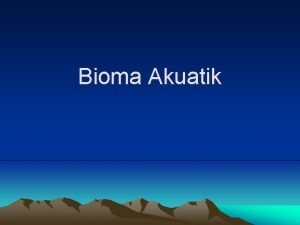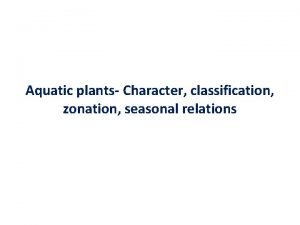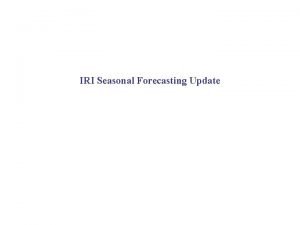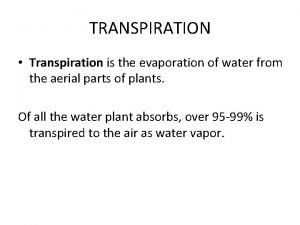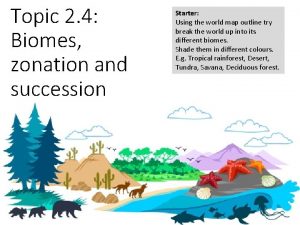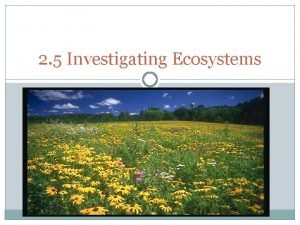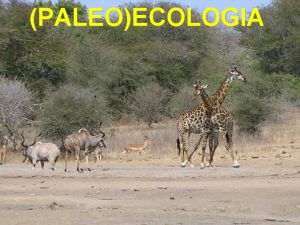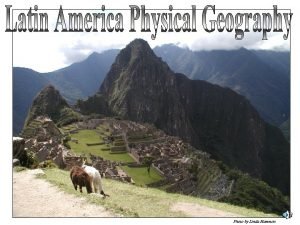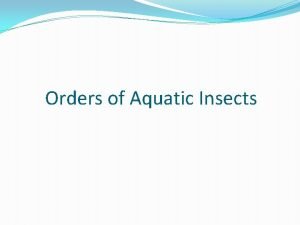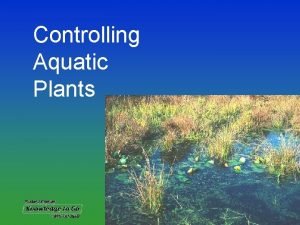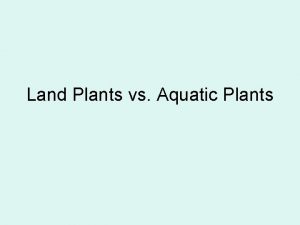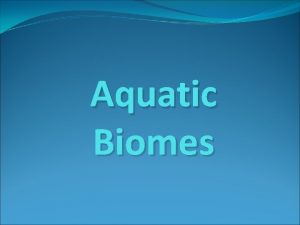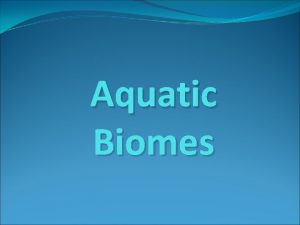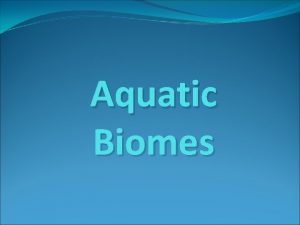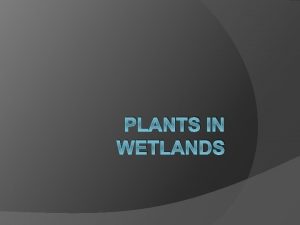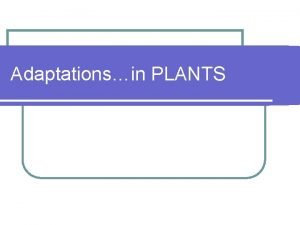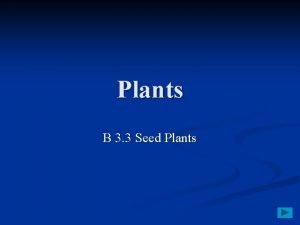Aquatic plants Character classification zonation seasonal relations Character
















- Slides: 16

Aquatic plants- Character, classification, zonation, seasonal relations

Character of larger aquatic plants • Larger aquatic plants constitute a heterogeneous group composed of a few Bryophytes and Pteridophytes and many of the families of Spermatophytes. • They are restricted in distribution to the general vicinity of the shores and to the shallow water areas.


• In general, the aquatic plants can be grouped in to 3 assemblages: • 1. Emergent – those rooted at the bottom and projecting out of the water for part of their length eg, common species of bulrush, Scirpus • 2. Floating - these which wholly or in part float in the surface of water and often do not project above it eg. Duck weed Lemna and • 3. Submerged - those which are continuously submerged eg, Vallisneria.


Biological classification of the larger aquatic plants • A. Plants roots in the bottom • 1) Terrestrial plants capable of living at least temporarily as submerged water plants without any marked adaptation of leaves to aquatic life eg: Achillea ptarmica, Nepeta hederacea • 2) Plants sometimes terrestrial, sometimes with submerged leaves but different from aerial type and associated with flowering stage • 3) Plants which produce 3 types of leaf (a) submerged (b) floating and (c) aerial

Achillea ptarmica Nepeta hederacea

• 4) Plants which in certain instances may occur as land forms but normally submerged and characterized by a creeping axis bearing long, branching leafy shoots with no floating laves • a. Leafy aerial shoots produced at flowering period eg, Myriophyllum • b. Inflorescence raised out of water but not aerial foliage leaves eg. Potamogeton, Myriophyllum • c. Inflorescence submerged but organs raised to the surface eg. Anacharis • d. Inflorescence entirely submerged eg. Najas

Myriophyllum Potamogeton Anacharis Najas

• 5) Plants which may occur as land forms but commonly submerged characterized by an axis forms with linear leaves arise • 6) Plants which are entirely submerged having vegetative either root or shoot naturally attached to the substratum • B. a) Plants which are not rooted to the bottom but live unattached in the water • 1) Plants with floating leaves, flowers raised into the air and roots not penetrating the bottom eg. Spirodella, • 2) Rootless eg. Wolffia • b) Plants entirely or practically submerged; Rooted but not penetrating bottom eg. Lemna and Rootless eg. Utricularia, Ceratophyllum

Spirodella, Wolffia Ceratophyllum

Nekton • The term nekton has been coined by Ernst Heckal (1890). Nekton is derived from Greek word means swimming. • The term nekton is used to designate those organisms which swim freely in water and possess locomotion enabling them to have independent drifting movement along the water flowage system. • In limnetic regions of inland waters, the nekton is composed almost entirely of fishes.

• The limnetic nekton may inhabit the whole of open water of a lake and down to its greatest depth. In contrast to the limnetic region, the littoral area is the zone of greater nekton population. In addition to the fishes (young and mature), numerous free swimming invertebrates occur mainly insects. • Major groups of vertebrates including fishes, Amphibia, Retillia, Aves and Mammalian are more or less representative of water and some time free swimming in nature.

Benthos • The term benthos includes all bottom dwelling organisms, comprising the great assemblages of plants and animals. Benthos includes the organisms of the bottom from uppermost water bearing portion of a body of water right up to the greatest depths.

Classification of benthic regions • 1. Lake zone: • There are usually 3 zones and in exceptionally in deep lakes there are 4 zones, they are Littoral, Sublittoral, Profundal and Abyssal zones. • i) Littoral Zone : Extends from water’s edge to the lakeward limit of rooted vegetation. • ii)Sublittoral Zone : From lakeward limit of vegetation down to about the level of the upper limit of the hypolimnion. • iii) Profundal zone : The entire lake floor that bounds the hypolimnion • iv) Abyssal : Present only in lakes of depths greater than 600 m.

 Bioma air laut
Bioma air laut Classification of aquatic plants
Classification of aquatic plants Iri moore model
Iri moore model Anatomical adaptation of hydrophytes
Anatomical adaptation of hydrophytes Site of transpiration
Site of transpiration Zonation and succession
Zonation and succession Zonation and succession
Zonation and succession Zonation and succession
Zonation and succession K strategist curve
K strategist curve Sepkoski
Sepkoski Altitudinal zonation in latin america
Altitudinal zonation in latin america Classification of aquatic insects
Classification of aquatic insects Employee relations in public relations
Employee relations in public relations Fern is vascular or nonvascular
Fern is vascular or nonvascular Non vascular plants
Non vascular plants Features of non flowering plants
Features of non flowering plants C3 plants vs c4 plants
C3 plants vs c4 plants
